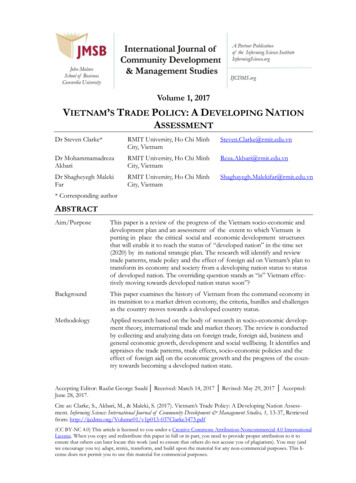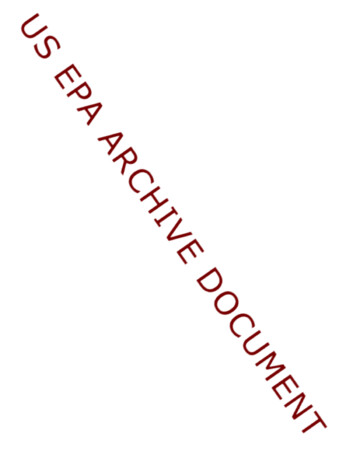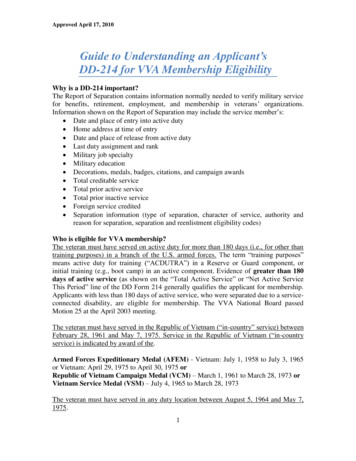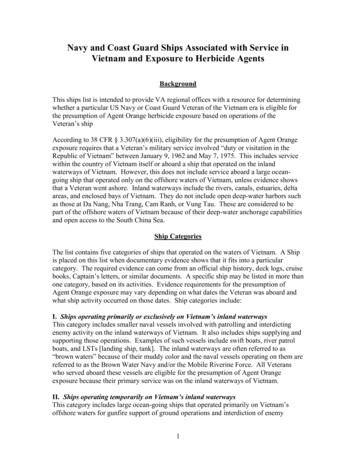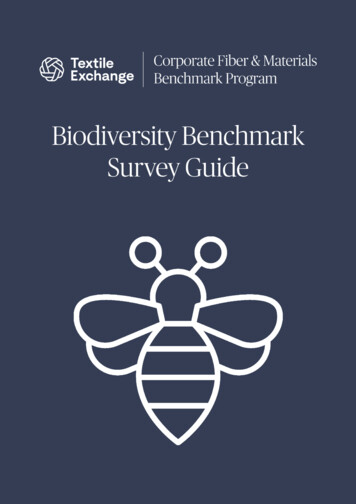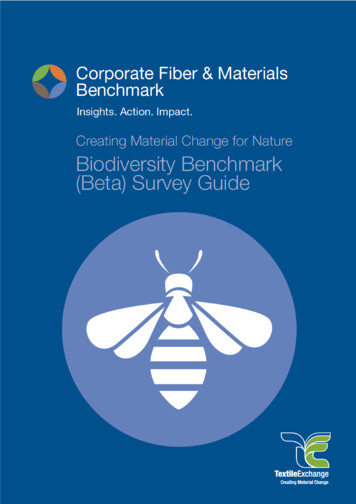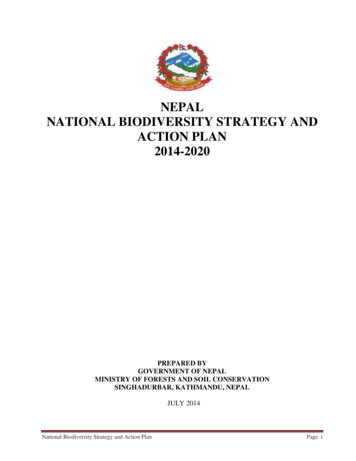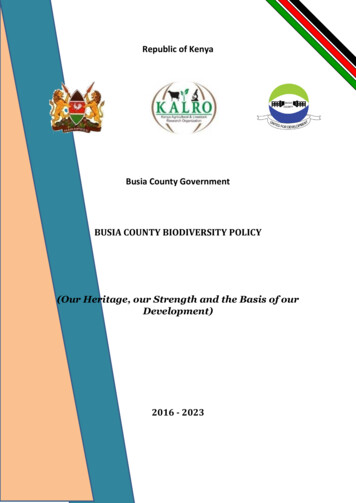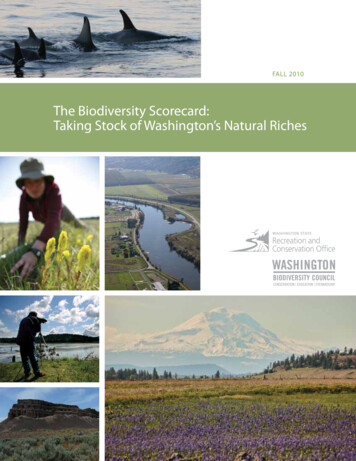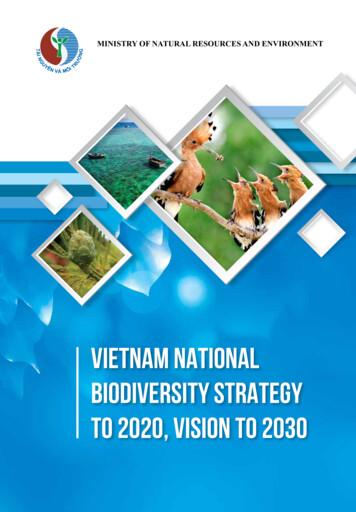
Transcription
MINISTRY OF NATURAL RESOURCES AND ENVIRONMENTVIETNAM NATIONALBIODIVERSITY STRATEGYto 2020, vision to 2030
INDEXLIST OF ACRONYMS AND ABBREVIATIONS6LIST OF TABLES7LIST OF FIGURES8PREFACE10PART 1: CONTEXT151.1.Richness and role of Vietnam’s biodiversity151.1.1. Richness of Vietnam biodiversity151.1.2. Global importance of Vietnam’s biodiversity261.1.3. The role of biodiversity in supporting the national economy and human1.2.1.3.well-being in Vietnam33Direct causes of biodiversity degradation in Vietnam351.2.1. Illegal and excessive exploitation of biological resources361.2.2. Fragmentation and Degradation of Habitats and Ecosystems371.2.3. Pollution461.2.4. Introduction of Invasive Alien Species461.2.5. Climate change481.2.6. Forest fires48Conservation and sustainable use of Vietnam’s biodiversity491.3.1. Policy and legal framework491.3.2. Institutional arrangements571.3.3. Conservation and sustainable use of biodiversity591.3.4. Management and support measures691.4. Opportunities and challenges751.4.1.Challenges751.4.2. Opportunities85PART 2: VIEWPOINTS - VISION - GOALS932.1.Viewpoints932.2.Vision to 2030932.3.Overall target to 2020932.4.Specific targets93MINISTRY OF NATURAL RESOURCES AND ENVIRONMENT3
PART 3: MAJOR TASKS943.1. Task content943.1.1. Conservation of natural ecosystems943.1.2. Conservation of wildlife and endangered, rare and precious species983.1.3. Sustainable use, fair and equitable access, and sharing of benefits derivedfrom ecosystems and biodiversity1013.1.4. Control activties that have negative impacts on biodiversity1023.1.5. Biodiversity conservation in the context of climate change1033.2. List of priority programs, plans and projects1053.3. Solutions for implementation1073.3.1. Change in behavior and awareness of state management organizationsand communities towards biodiversity conservation and sustainable use1073.3.2. Improve the legislative and institutional system and strengthen the capacityof law enforcement for the implementation of legal acts on biodiversity1083.3.3. Strengthen integration of biodiversity conservation in policy development1093.3.4. Promote scientific research, development and the application of moderntechnology in conservation and sustainable use of biodiversity1093.3.5. Increase financial resources for biodiversity conservation1093.3.6. Promote integration and international cooperation in conservation andsustainable use of biodiversity4110PART 4: IMPLEMENTATION ARRANGEMENTS1114.1. Ministry of Natural Resources and Environment1114.2. Ministry of Planning and Investment1114.3. Ministry of Finance1114.4. Ministry of Agriculture and Rural Development.1114.5. Other ministries and central agencies1114.6. Provincial People’s Committees and centrally-managed cities1124.7. District People’s Committees1124.8. Business community1124.9. Socio-political organizations, social organizations, and social vocational services.112REFFERENCES113APPENDIX1: PROCESS OF THE NBSAP DEVELOPMENT116APPENDIX 2: IMPLEMENTATION OF BAP 1995 AND 2007118VIETNAM NATIONAL BIODIVERSITY STRATEGY - TO 2020, VISION TO 2030
APPENDIX 3: RELEVANCE BETWEEN THE NBSAP AND AICHI BIODIVERSITYTARGETS128APPENDIX 4: LIST OF PROTECTED AREAS, BIODIVERSITY FACILITIES ANDBIODIVERSITY CORRIDORS1394.1.139LIST OF PROTECTED AREAS(issued together with Decision 1107/QD-BTNMT dated May 12, 2015 of theMinister of Natural Resource and Environment promulgating the List of ProtectedAreas under Law on Biodiversity)4.2.LIST OF PROTECTED AREAS151(issued together with Decision 45/QD-TTg dated January 4th, 2014 of the PrimeMinister approving the National Biodiversity Conservation Master Plan to 2020,vision to 2030)4.3.LIST OF BIODIVERSITY FACILITIES164(issued together with Decision 45/QD-TTg dated January 4 , 2014 of the PrimethMinister approving the National Biodiversity Conservation Master Plan to 2020,vision to 2030)4.4.LIST OF BIODIVERSITY CORRIDORS168(issued together with Decision 45/QD-TTg dated January 4 , 2014 of the PrimethMinister approving the National Biodiversity Conservation Master Plan to 2020,vision to 2030)APPENDIX 5. LIST OF MARINE PROTECTED AREAS UPTO 2015171(According to Decision No. 742/QĐ-TTg dated May 26, 2012 of the Prime Minister)APPENDIX 6. INDICATORS FOR MONITORING AND EVALUATION OF NBSAPIMPLEMENTATION172MINISTRY OF NATURAL RESOURCES AND ENVIRONMENT5
LIST OF ACRONYMS AND ABBREVIATIONSASEANAssociation of Southeast Asian NationsCBDConvention on Biological DiversityCITESConvention on International Trade in Endangered Species of Wild Faunaand Flora6FSCForest Stewardship CouncilGDPGross Domestic ProductGEFGlobal Environment FacilityIUCNInternational Union for Conservation of NatureJICAJapan International Cooperation AgencyPAProtected AreaNRNature ReserveMAPMedicinal and Aromatic PlantsNBSAPNational Biodiversity Strategy and Action PlanNTFPNon-Timber Forest ProductsMARDMinistry of Agriculture and Rural DevelopmentMONREMinistry of Natural Resources and EnvironmentODAOfficial Development AssistancePESPayment for Ecosystem ServiceREDD Reduced Emissions from Deforestation and DegradationUNFCCUnited Nations Framework Convention on Climate ChangePCPeople’s CommitteeNPNational ParkWWFWorld Wildlife FundVIETNAM NATIONAL BIODIVERSITY STRATEGY - TO 2020, VISION TO 2030
LIST OF TABLESTable 1:The abundance of species in Vietnam24Table 2:24 new genera of plants described for the first time26Table 3:GDP by economic sector at 2010 prices34Table 4:Reduction of coral reefs in some coastal regions in Vietnam44Table 5:Quality of coral reefs in Vietnam (World Natural Resource Institute, 2008)44Table 6:List of alien invasive species in Vietnam47Table 7:Recent National Strategies, Programmes and Plans for BiodiversityConservation50Table 8:Protected areas in SUF system59Table 9:Changes of forest area and coverage in Vietnam (period 1990-2010)63Table 10:System of fauna ex-situ conservationsites66Table11:System of flora ex-situ conservation sites68Table 12:Biodiversity-related international conventions/agreements ratified by Vietnam74Table 13:Population in Vietnam75Table 14:Fisheries area, volume and production value79Table 15:Forestry value at 2010 comparision price by activities80Table 16:Forestry land planning by 202096Table 17:List of biodiversity facilities planning system under the National BiodiversityMaster Plan by 2020, vision to 2030100MINISTRY OF NATURAL RESOURCES AND ENVIRONMENT7
LIST OF FIGURESFigure 1.Map of forest ecoregions in Vietnam16Figure 2.Forest ecoregions in Vietnam (under forest vegetation classification)17Figure 3.Map of terrestrial ecosystems of Vietnam based on types of forest vegetation18Figure 4.Some typical terrestrial ecosystems in Vietnam20Figure 5.Map of marine bio-geographical zoning and marine biodiversity zoning,and MPA groups of Vietnam21Figure 6.Some typical coastal ecosystems in Vietnam22Figure 7.Distribution of domestic livestock breeds in Vietnam25Figure 8.Some native livestockspecies in Vietnam26Figure 9.Some endangered precious and rare species prioritized for protection in Vietnam 29Figure 10. Vietnam network of biosphere reserves30Figure 11. Map of distribution of forest types and some precious and rare animals inregions of Vietnam31Figure 12. Map on distribution of some precious and rare wildlife in Central Highland32Figure 13. Key biodiversity areas in Vietnam33Figure 14. Relationship of forest biomass carbon, key biodiversity areas andbiodiversity corridors35Figure 15. Annual quantity of traded wild animals36Figure 16. Some confiscated timber cases37Figure 17. Some photos of over-exploitation in South-West sea38Figure 18. Correlation between population density, poverty and forest cover39Figure 19. Annual quantity of confiscated timber (m3)39Figure 20. Conversion of forest land in Vietnam from 2002 to 200940Figure 21. Area of forest converted for infrastructure building and non-agriculturalpurposes by year40Figure 22. Table of forest area converted for other use purposes from 2005 to 201041Figure 23. Some pictures of the conversion of coastal ecosystems into aquaculture sites42Figure 24. Progressive reduction of mangroveforest areas in Vietnam from 1943 to 201243Figure 25. Changes indistribution of coral reefs in Halong Bay, Cat Ba from 1995 to 2011 438VIETNAM NATIONAL BIODIVERSITY STRATEGY - TO 2020, VISION TO 2030
Figure 26. Map of existing and proposed large hydropower reservoir development in Vietnam45Figure 27. Amount of forest loss due to fores fire from 2002 to 201048Figure 28. Organizational structure of biodiversity state management58Figure 29. Vietnam Protected Area System (under classification of Law on Forest Protectionand Development and Law on Fisheries)60Figure 30. Map of protected areas (under classification of Law on Biodiversity)61Figure 31. Progress of forest coverage62Figure 32. Forest area by years (from 1943 to 2009)62Figure 33. Forest cover from 1943 to 201063Figure 34. Map of marine PA system (s) and inland water PA system (B)64Figure 35. Distribution of population in Vietnam76Figure 36. Maps of correlation between poverty incidence and forest cover in Vietnam69Figure 37. Map of proportion of land used for agriculture (A), forestry (B) and aquaculture (C) 80Figure 38. Increased temperature and rising sea level in Vietnam in the climate changescenario 2012 (MONRE)85Figure 39. Carbon density in Vietnam88Figure 40. Map of three types of forest management under REDD program and biomasscarbon density89Figure 41. Relationship of forest biomass carbon, forest cover change and threatenedspecies richness90Figure 42. Forest biomass carbon and threatened species richness91Figure 43. Map of Protected Areas planning by 2020 under Law on Biodiversity95Figure 44. Forest cover of Vietnam from 1943 to 2010 and projection to 202096Figure 45. Map of biodiversity corridors planning by 2020, vision to 2030106MINISTRY OF NATURAL RESOURCES AND ENVIRONMENT9
PREFACEViet Nam is endowed with extraordinarybiodiversity, with many types of ecosystems,species and genetic resources, which arerich and endemic. In Vietnam, biodiversitybrings direct benefits to humans, cially sectors such as agriculture, forestryand fisheries; ensuring the food security forthe country; maintaining genetic resources10for farming animals and crops; providingThe research results show that hundreds ofconstructionpharmaceuticalterrestrial and inland freshwater species newmaterials and food. In addition, ecosystemsto science have been described for the firstplay an important role in climate regulationtime in Vietnam, reflecting the high endemismand environmental protection. Biodiversityof the biota. From 2006 to 2011 alone, overhas also been a cultural and artistic inspiration100 species new to science were discoveredto humanity for millennia.and described for the first time in Vietnam,At present in Vietnam, some 49,200 speciesin particular there were 21 reptile species,materials,have been identified, consisting of nearly6 frog species and 1 ferret species. Many7,500 microorganisms; 20,000 terrestrialscientists believe that there are many otherand water plants; around 10,500 terrestrialwildlife species in Vietnam still unknown,animals; about 2,000 invertebrates andand the number of such known species mayfreshwater fish; and in the sea, there are overbe much lower than the actual number of11,000 marine species1.species in nature2.1National Biodiversity Report 20112Updated information based on the National Biodiversity Report 2011VIETNAM NATIONAL BIODIVERSITY STRATEGY - TO 2020, VISION TO 2030
and the Fisheries Law, 2003. In particular, theBiodiversity Law, 2008 marks an importantmilestone for conservation that has identifiedthe principles and priorities of biodiversityconservation at all levels, from national andministerial to local levels; creating the legalbasis for local community involvement in theconservation of natural resources throughnew mechanisms of co-management andbenefit sharing.In recent years, the Government has issuedpolicies, strategies and plans in order topromote the conservation of biodiversity. In1995, the first Biodiversity Action Plan (BAP1995) was issued after Vietnam became aIn the composition of the identified species,882 rare plants and animals with higheconomic value are threatened at differentlevels, which are listed in the Vietnam RedBook2007.Accordingtoestimations,Vietnam is one of the centres with highlydiverse local genetic resources of plants andanimals in the world, including about 800agricultural crop varieties, and 14 key cattleand poultry varieties. These are valuablenative genetic resources in Vietnam, whichneed to be protected, conserved anddeveloped.member of the Convention on BiologicalDiversity in 1994. BAP 1995 became theguideline for biodiversity conservation inVietnam during the period 1995-2005. By2005, the Ministry of Natural Resources andEnvironment had submitted the “BiodiversityAction Plan to 2010 with vision to 2020” (BAP2007) to the Prime Minister for approval.BAP 2007 issued by the Prime Minister atDecision 79/2007/QD-TTg dated May 31,2007. After three years of implementationof BAP 2007, the Ministry of NaturalResources and Environment conducted areview and reported to the Prime Ministerofon the implementation of Decision 79/2007/biodiversity, in the last two decades, theQD-TTg. The report pointed out that thereGovernment has issued a relatively completewere a number of achievements obtainedlegal framework related to biodiversityin biodiversity conservation such as theconservation. Many important laws in theincrease in the area of protected ecosystems,field of natural resource management havediscovery of new species meaningful tobeen enacted and completed, such as thescience, and the conservation, restorationForest Protection and Development Lawand development of genetic resources1991 (amended in 2004); the Land Use Law,valuable in selection and breeding. On the1993 (amended in 1998, 2003, and 2013);other hand, there were still many challengesthe Environmental Protection Law, 1993requiring a vision and strategic steps in line(amended in 2005 and 2014); the Waterwith the international and domestic contextResources Law, 1998 (amended in 2012);of the new period.InrecognitionoftheimportanceMINISTRY OF NATURAL RESOURCES AND ENVIRONMENT11
Vietnam is a developing country and transitioningto a middle-income country. People’s lives haveimproved and the pressure on biodiversity resourcesdue to poverty has reduced; however, unsustainableconsumption patterns and conservation planningproblems have emerged as new challenges ervation issues that need to be resolved, andmechanisms that need to be developed, to es in a fair and equitable way that promotescommunity participation and allows communitybased management, conservation and developmentof biodiversity. Methodology and approaches nse and adaptation to climate change alsoneed be considered. The government has initiatedand is steering towards a green and sustainableeconomy for the country; but while rapid growth hasbought economic and social benefits, it has also puta lot of pressure on biodiversity. Vietnam’s populationincreased from less than 73 million in 1995, to over90 million in 2014, making Vietnam one of the mostpopulous countries in Asia and creating a largedemand for resource consumption and land use.The global context also brings new challenges andopportunities. On the one hand, climate change hasbecome more severe and is having an increasinglynegative impact on biodiversity; while on the otherhand, biodiversity conservation has been given higherattention than ever before at the global scale, with 2010being internationally identified as the biodiversity yearand 2010-2020 as the biodiversity decade by the UN.For the first time in history, the United Nations GeneralAssembly in its 65th session held a high-level meetingon biodiversity with the participation of the leaders ofstates and governments. Also, in the 10th Conferenceof the Parties to the Convention on Biological Diversityheld in the city of Nagoya, Aichi province, Japan, theParties pledged to build their new biodiversity strategyfor the next decades including a vision to 2050 andmission to 2020, as well as implementation measuresand mechanisms to monitor and evaluate progresstowards achieving the global goals.12
In this context, developing a National BiodiversityStrategy to 2020 with a vision to 2030 is both to fulfilcommitments under the Convention on BiologicalDiversity to which Vietnam is a Party, and to identifygoals, objectives and tasks for the conservation andsustainable use of biodiversity in accordance withdevelopments in the new period; such as:1. Identify the main causes of biodiversity5. Genetic resources are conserved andloss; thereby reducing the pressuredeveloped through the investigation,directly affecting biodiversity andstudy and inventory of biodiversitypreventing the decline of biodiversity inand biological resources, as well asprotected areas;indigenous knowledge on the use ofbiological resources on a national scale;2. Properly resolve conflicts between6. Promote the management and controlconservation and development,the risks from invasive alien species,especially the conversion of landgenetically modified organisms anduse and water in areas with hightheir products, to the environment andbiodiversity;human health;3. Conserve the system of protected7. Benefits from biodiversity andareas (forests, wetlands, marine)ecosystem services should becontaining typical ecosystems, andshared fairly and equitably withvarious key biodiversity areas, andthe participation of communities.promote ecosystem services. PriorityDevelop, improve and apply regimesis given to strengthen conservationon access to genetic resources andstatus in a number of protected areasbenefit sharing. Develop models forof ecological importance;payments for ecological services inorder to socialize conservation;4. Enhance biodiversity conservation8. Study and evaluate the role ofand development at the level ofbiodiversity in response to climateecosystems, species and geneticchange and propose appropriateresources. Reduce and then stopsolutions.the exploitation, illegal trade,and overexploitation of biologicalresources, especially endangered, rareand precious species;PMINISTRY OF NATURAL RESOURCES AND ENVIRONMENT13
Pursuant to document no. 3533/VPCP-QHQT dated May 31, 2011 and documentno. 4148/VPCP-KGVX dated June 23, 2011 by the Prime Minister, the Ministry ofNatural Resources and Environment submits the draft of the National BiodiversityStrategy to 2020, with a vision to 2030, including: Part I: Context Part II: Viewpoints, vision, goals Part III: Strategic tasks and priority programs, plans and projects Part IV: Implementation arrangements, monitoring and reportingThe National Biodiversity Strategy to 2020 with vision to 2030 is an integral part ofthe Socio-Economic Development Strategy in order to protect and sustainably usebiodiversity resources, to provide the basis for Vietnam’s sustainable developmentin the current context of climate change.14VIETNAM NATIONAL BIODIVERSITY STRATEGY - TO 2020, VISION TO 2030
Part 1:CONTEXT1.1. RICHNESS AND ROLEVIETNAM’S BIODIVERSITYOFrise to a diverse range of natural ecosystemsincluding a wide variety of forest ecosystem1.1.1. Richness of Vietnam biodiversityVietnam’s territory stretches over 15 latitudesfrom North to South, with a length of about1,650 km on the Indochina Peninsula and atotal natural land area of 330,591 km2. Dueto the bisected topography with a relativelyhigh annual average rainfall, the network ofrivers and streams is relatively dense withthe river network density ranging from under0.5-2 km/km2. On the continental part,there are 16 major river basins, of which10 river basins cover an area of more than10,000 km2, accounting for 80% of the totalcountry area. The two largest river systemsare the Red River in the North and Mekongtypes: Evergreen closed tropical humidforest;Semi-deciduous closed tropical humidforest;Evergreen broad-leaved forests onlimestone;Coniferous forests; Dry dipterocarp forest;Mangroveforests,Melaleucacajuputiforests; and Bamboo forest.Besides theeight types of forest ecosystems, scientistshave classified 14 types of forest vegetationbased on ecological factors (Thai VanTrung, 1999). Based on the natural factorsof climate, topography, geology, and soil,Vietnam’s continent is divided into eightforest eco-regions with 47 sub-regions thathave their own vegetation and landscapecharacteristics.River in the South, which create two majorIn addition to forest ecosystems, otherbasins consisting of the Red River Delta andimportant ecosystems include grasslands,Mekong Delta. The majority of Vietnam’sinland wetlands, dunes, inter-tidal mudflats,territory is hilly and mountainous with theestuaries, sea grass beds, coral reefshighest peak in Hoang Lien Son range beingand deep-sea areas. Also due to naturalthe Fanxipan at 3,143 m above sea level.conditions, ecosystems and species inVietnam’s topography and climate have givenVietnam are small in size, and very vulnerable.MINISTRY OF NATURAL RESOURCES AND ENVIRONMENT15
Figure 1. Map of forest ecoregions in Vietnam(Source: Report on Forest Ecoregions in Vietnam, UN-REDD, Research Center for ForestEcology and Environment - RCFEE, 2011)16VIETNAM NATIONAL BIODIVERSITY STRATEGY - TO 2020, VISION TO 2030
Based on study documents of Wege et al. (1999), in 2013, BCA, WWF and Stockholm Universitydeveloped a map of Vietnam’s ecoregions according to UNESCO’s forest plantation classification.Figure 2. Forest ecoregions in Vietnam (under forest vegetation classification)(Source: BCA, WWF and Stockholm University, 2013)MINISTRY OF NATURAL RESOURCES AND ENVIRONMENT17
Under the project “Mainstreaming an Ecosystem-based approach to Climate Change intoBiodiversity Conservation Planning in Vietnam” (EBA Project), BCA incooperation with WWF andStockholm University, developed a map of ecosystems in Vietnam. However, this map does notshow marine ecosystems, particularly the important ecosystems such as coral reefs and seagrass beds.Figure 3. Map of terrestrial ecosystems of Vietnam based on types of forest vegetation(Source: BCA, WWF and Stockholm University, 2013)18VIETNAM NATIONAL BIODIVERSITY STRATEGY - TO 2020, VISION TO 2030
Tropical moist ever-green forestDipterocarp woodland ecosystemConiferous forest ecosystemLimestone forest ecosystemMangrove forest ecosystemMelaleuca forest ecosystem in freshwater swampBamboo forest ecosystemCave ecosystem (Sơn Đòong cave)MINISTRY OF NATURAL RESOURCES AND ENVIRONMENT19
River ecosystem (Côn River, Bình Định)Lake ecosystem (West lake, Hanoi)Agricultural ecosystemUrban ecosystemFigure 4. Some typical terrestrial ecosystems in VietnamThe coastline is over 3,260 km long with300m at the outer boundary. The continentalthousands of coastal islands, the Paracelslope has an average depth of 2,500 -and Spratly archipelagos, and an exclusive3,000m, and up to 4,000m at the deepesteconomic ocean zone of over 1 million km2.points. The abyssal zone has an averageBased on the terrain and hydrography, theredepth of 4,000m, with the deepest areasare five sea regions including the Northern,up to 5,500m. The abyssal plain also hasNorth-Central, Mid-Central, South East,a system of underground mountains with aand South West regions. Within these seaheight of 200-3800m, with coral stone crestsregions there are 11 coastal areas includingvery specific to the sea terrain conditionsMong Cai-Do Son; Do Son-Mui Ron; Mui(Resources and Environment Sea, VolumeRon-Hai Van; Hai Van-Sa Huynh; Sa Huynh-IV, 2003). So far, there is very limited dataDai Lanh cape; Dai Lanh-Ca Na; Ca Na-Vungavailable on biodiversity in the continentalTau; Vung Tau-Ca Mau cape; Ca Mau-Rachshelf, continental slope and deep-sea areasGia; and Rach Gia-Ha Tien (Tran Duc Thanh,of Vietnam. If a survey of marine biodiversity2015).is conducted, there would certainly be someVietnam’s continental shelf is an extensioninteresting discoveries.of the Asian continent, with a depth of 150-20VIETNAM NATIONAL BIODIVERSITY STRATEGY - TO 2020, VISION TO 2030
At the geographical level, some experts from IUCN (1995) showed that Vietnam’s sea is locatedin the sub-tropical eastern edge of the region 13- East Asia Sea including Vietnam’s North andSouth; and the Eastern Gulf of Thailand.Based on natural conditions, Vietnam’s sea region can be divided into six biodiversity regions,as follows:Zone 1: Tonkin Gulf (up to the southernZone 4: Sea region in SouthEastern Coastedge of Con Co island, Quang Tri province)(from Vung Tau to Ca Mau)Zone 2: Sea region in mid-central coastZone 5: Sea region in South Western(from Con Co island to Mui Dinh cape toCoast (from Ca Mau to Phu Quoc island inPhan Rang – Varella cape)Thailand Gulf)Zone 3: Sea region in South Central CoastZone 6: Offshore sea region(from Mui Dinh cape to Vung Tau)Spratly and Paracel IslandsMarine bio-geographical zoning in Vietnam(Source: IUCN, 1995)includingMarine biodiversity and MPA groups ofViet NamLegend: I. Sub-tropical eastern edge of(Nguyen Huy Yet, 2000)the region 13- East Asia Sea; 1.NorthernVietnam; 2.Southern Vietnam; 3.EasternGulf of Thailand; 4.Central Gulf of Thailand;5.Western Gulf of Thailand; 6. NorthEastMalaysia.Figure 5. Map of marine bio-geographical zoning, marine biodiversity zoning,and MPA groups of VietnamMINISTRY OF NATURAL RESOURCES AND ENVIRONMENT21
In the six marine biodiversity zones mentionedabove, about 20 types of marine ecosystemscan be identified. Typical marine ecosystemsin coastal zones include tidal flats, mangroveforests, lagoons, bays, salt lakes on islands,coral reefs, and seagrass beds. In addition,there are ecosystems surrounding inshoreand offshore islands, especially in the deepsea areas surrounding the Spratly andParacel Islands. Of these ecosystems,Lagoon ecosystem (Tam Giang Lagoon)mangrove forests, coral reefs and seagrassbeds have highest biodiversity levels andmost important value for conservation.Châu Truc/Tra O swamp ecosystem (Binh Dinh)Coral reef ecosystemBay ecosystem (Ha Long Bay)Sea grass ecosystemSalt-water lake ecosytem in Cong Do island,Ha Long Bay (Source: Waltham Tony)Figure 6. Some typical coastal ecosystems in Vietnam22VIETNAM NATIONAL BIODIVERSITY STRATEGY - TO 2020, VISION TO 2030
Due to the diversity of terrestrial and aquaticof birds and 312 species of mammals. Inecosysrems, including inland wetlands andfreshwater there are about 1,500 species ofmarine ecosystems, species composition inmicroalgae and seaweed, over 1,000 speciesVietnam is also very diverse and abundant.of invertebrates and 600 species of fish; andVietnam is home to nearly 16,500 species ofin the sea there are more than 1,200 speciesterrestrial vascular plants, fungi and seaweed,of seaweed, grass and microalgae, overa high percentage of which are believed to7,000 species of invertebrates, 2,500 fishbe endemic (about 30%). This shows a highspecies and approximately 50 species of seadiversity of flora in Vietnam. On land, there aresnakes, turtles and mammals3. In addition,about 10,500 species of animals, includingscientists say that the number of species inapproximately 8,000 species of insects andVietnam may be much higher than this, asinvertebrates in the soil, nearly 500 speciesspecies new to science are continually beingof reptiles and amphibians, 850 speciesdiscovered and described.3East Sea monograph -Episode IV-organisms and marine ecology, Vietnam Academy of Science andTechnology (2009); National Biodiversity Report, MONRE (2011).MINISTRY OF NATURAL RESOURCES AND ENVIRONMENT23
Table 1: The abundance of species in VietnamSpecies Group1. PhytoplanktonThe number of identified speciesAbout 2,000- Freshwater1,438- Marine5372. Aquatic plantsAbout 680- FreshwaterAbout g 20- Marine6533. Sea grass144. Mangrove plants945. Terrestrial plants16,428- Vascular plants13,747- Non-vascular plants (moss, fungi)2,6816. Freshwater invertebratesAbout 10007. Marine invertebratesAbout 7,000- Zooplankton657- ZoobenthicAbout 6,3008. Soil invertebratesAbout 1,0009. Parasitic helminthes19010. Insects6,60011. FishAbout 3,500- Freshwater fishAbout 600- Marine fishAbout 2,50012. Frogs16713. Terrestrial reptiles31714. Marine reptiles (sea snakes, turtles)2115. Birds84016. Terrestrial mammals31217. Marine mammals25Source: National Biodiversity Report, MONRE (2011), East Sea monograph -Episode IVorganisms and marine ecology, Vietnam Academy of Science and Technology (2009)24VIETNAM NATIONAL BIODIVERSITY STRATEGY - TO 2020, VISION TO 2030
Apart from the diverse natural biology, Vietnam also possesses a wealth of agricultural biodiversity.It is situated within one of the Vavilov Centres of Origin of domesticated plants and has beenthe source of some 40 domestic livestock breeds. Local crop varieties and livestock breeds,including the famous pot-bellied pig, have been developed over many hundreds of years andoften possess valuable characteristics such as disease and pest resistance. More than 6,000varieties and genotypes of rice have been recorded from Vietnam.Figure 7. Distribution of domestic livestock breeds in Vietnam(Source: MONRE, 2011, National Biodiversity Report)MINISTRY OF NATURAL RESOURCES AND ENVIRONMENT25
Pintail (Anas acuta acuta)Mong Cai Pig (Sus domesticus)Figure 8. Some native livestock species in Vietnam1.1.2.GlobalimportanceofVietnam’s biodiversityBesides the advantage of unique24 new genera of plants described since 1993:natural ecosystems and diverse1.Hiepia (Asclepiadaceae) - 2012species composition, over the last2.Lockia (Orchidaceae) - 201220 years a range of new discoveries3.Theana (Orchidaceae) - 2012have highlighted and reconfirmed4.Lanonia (Ar
Forest cover of Vietnam from 1943 to 2010 and projection to 2020 96 Figure 45. Map of biodiversity corridors planning by 2020, vision to 2030 106. 10 IETNAM NATIONAL BIODIERSITY STRATEGY - TO 2020, ISION TO 2030 Viet Nam is endowed with extraordinary biodiversity, with many types of ecosystems,
